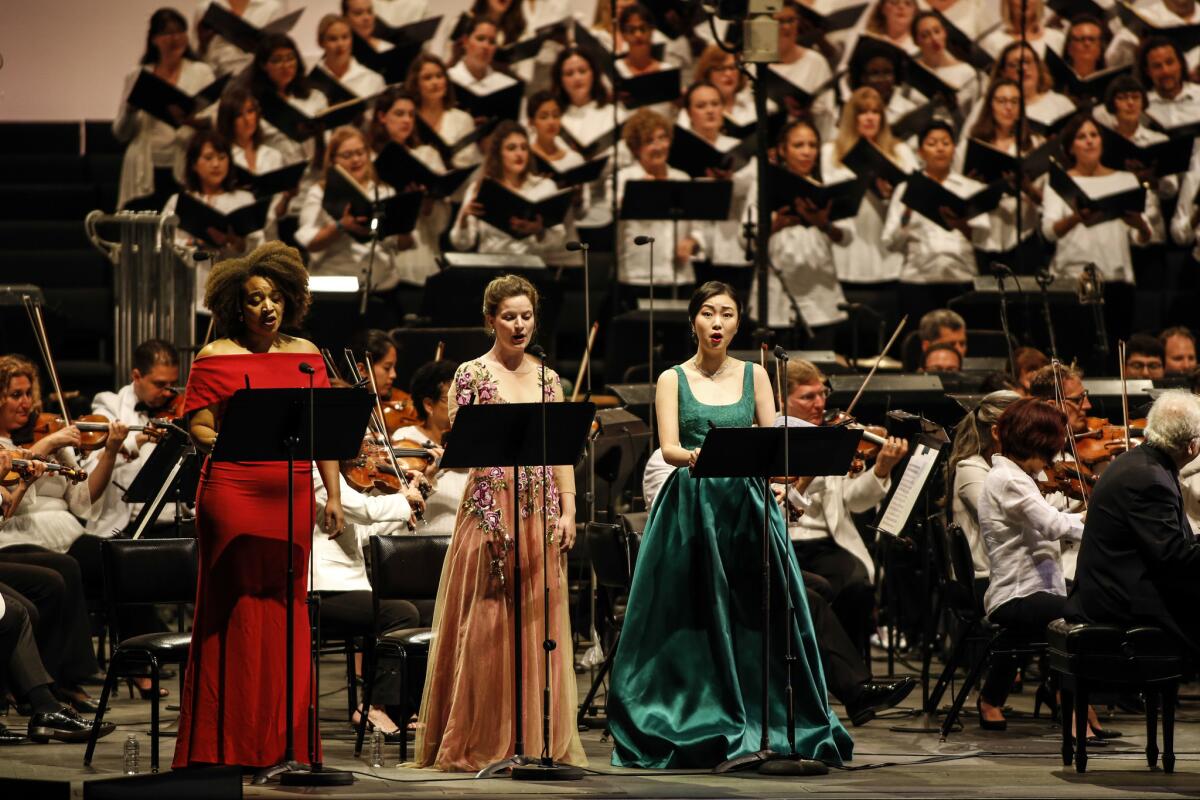Learning Matters: Parents singing to their children can provide lifelong lessons

- Share via
Driving past John Muir Elementary a couple weeks ago, I spotted my friend Kay Ladanyi, recently retired from teaching instrumental music in Glendale Unified schools. She was waiting for the “walk” light at the corner, so as soon as I got through the intersection, I found a spot to park and walked back to say “hello.”
I’m always happy to talk to Kay. Before my years on the Glendale Unified school board, I occasionally subbed in her music classes, and when our sons were in the Los Angeles Children’s Chorus, we roomed together as chaperones on a choir tour to Brazil.
I still have one of the notebooks she lent me from the materials she used teaching a music class for the masters in elementary education program at USC.
Since the university recently dropped the class from its curriculum, she’s hoping to continue her work with classroom teachers at another university, and I hope she does. Her education students often told her how much they appreciated what she taught them and how it influenced their classroom teaching.
Catching up a little on our families as well as our own activities, Kay explained she’d just come from her regular Friday volunteer work assisting Muir’s instrumental music teacher.
For as long as I can remember, Glendale Unified has had four music teachers for its 20 elementary schools, with each teacher traveling to five schools per week to provide instrumental music instruction to students in fourth through sixth grades.
Music is not part of Glendale Unified’s regular instruction, though some schools provide music classes with the support of school foundations or other grant funding.
Some schools also provide a before-or-after school chorus opportunity, but historically both the district’s requirements and its financial support for chorus, for which the teacher gets a stipend, are limited to 12 rehearsals and a concert.
Glendale Unified’s instrumental music program, taught by credentialed music educators, is available only to those students whose parents have signed them up and arranged to borrow, rent or buy instruments.
Those students leave their classrooms for their instrument-specific music class, such as beginning strings or woodwinds, on a weekly basis.
From my little bit of experience subbing in Kay’s classes, I can clearly recall how one student’s broken cello string could interrupt instruction, so I can readily imagine how much her help is appreciated by the teacher she assists.
But back to the curbside conversation, I told Kay I’d just come back from helping with our four young grandchildren in Milwaukee, and we laughed about the challenges of getting them out the door with all their snow clothes.
She asked if I was still writing a column, and I confessed how I’d been struggling that week to pull my thoughts together for a piece about early learning.
“I know what you should write about!” she exclaimed. “Mom’s aren’t singing to their children.”
She then shared her concern that too many children aren’t learning the songs sung for generations, the lullabies and folk tunes that have been part of every culture’s heritage and that fit in young children’s unique and delicate vocal range.
Kay expressed her concern that most parents don’t know how children can damage their voices by trying to sing like adults.
We commiserated about how much children are missing by not hearing and singing the children’s songs from which they can so enjoyably absorb poetry, history, culture and math.
Kay reminded me of what we’d heard from our children’s former choir director at the L.A. Children’s Chorus, Anne Tomlinson, who frequently spoke of the importance of selecting appropriate music for children.
She wanted children to experience poetry and melodies from which they could draw for comfort and joy their entire lives.
Fernando Malvar-Ruiz, the current artistic director of the chorus, shares Tomlinson’s commitment to the joys of childhood music education, as do the majority of children’s music educators I’ve come to know in the 32 years since I unexpectedly found myself leading a children’s choir.
I realize that school districts all across California are looking once again at steep budget cuts, and I know how lucky it is that Glendale Unified continues to offer an instrumental music program.
But I continue to hope our district may one day give all its children the songs children get in the weekly music “specials” in the two states where our daughter has taught.
I’m reminded how lucky our grandchildren are that their mother sings to them every night, just after reading a story or two.
Whatever the budgetary constraints on public education, we can do more to help parents understand the power they have to enrich their children’s learning and lives with a nightly story and song.
Joylene taught chorus at Muir and Marshall elementary schools and teaches a weekly musicianship class for the Los Angeles Children’s Chorus. Email her at jkate4400@aol.com.
